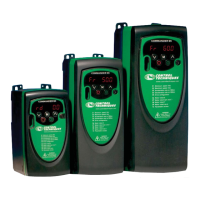
Do you have a question about the Control Techniques Commander SK and is the answer not in the manual?
| Output Voltage | 0-Input Voltage |
|---|---|
| Communication Options | RS485, Modbus, Ethernet |
| Enclosure Type | IP20, IP66 |
| Overload | 150% for 60 seconds |
| Protection | Overcurrent, Overvoltage, Undervoltage, Over Temperature, Short Circuit, Earth Fault |
| Cooling Method | Fan cooled |
| Options | Braking Resistors, Input Chokes, Output Filters, Keypad, Communication Modules |
| Operating Temperature | -10°C to +50°C (14°F to 122°F) |
Information about the drive's user-interface and machine control software.
Commitment to minimizing environmental impacts and product recycling guidelines.
Process of saving user-defined parameters to the drive's EEPROM.
Procedure for restoring factory default parameter settings.
Comparison of default parameter sets for European and US markets.
Definitions of terms used for software variables and their maximum allowed values.
Details on how parameter information is presented and structured within the guide.
Limitations and characteristics of 32-bit parameters in the drive.
Reasons and methods for performing a drive reset to implement parameter changes.
Procedures for saving parameter settings via keypad or serial interface.
Explanation of the coding system used to define parameter attributes.
Definitions of terms like Range, Default, Second motor parameter, and Update rate.
How parameters can be used as sources or destinations for drive functions and logic.
Information on parameter update rates and microprocessor task times for control functions.
Functions of the MODE, UP, and DOWN keys for drive operation and parameter editing.
Functions of the START and STOP/RESET keys for controlling drive operation.
Step-by-step procedure for navigating and modifying drive parameters using the keypad.
Details on how drive speed is displayed using mnemonics.
Details on how motor load is displayed using mnemonics.
Overview of SYPTLite software, its benefits, limitations, and system requirements.
Details on how user programs are executed, their priority, and performance considerations.
Introduction to the advanced parameter menus and parameter coding.
Instructions for configuring a terminal for Forward/Reverse operation in keypad mode.
How to use drive digital I/O to control an electro-mechanical brake.
Information on SM-I/O Lite and Timer options, including analog input/output resolution and sample times.
Details on the encoder input hardware and its limitations.
List of error codes and their corresponding fault reasons for I/O option modules.